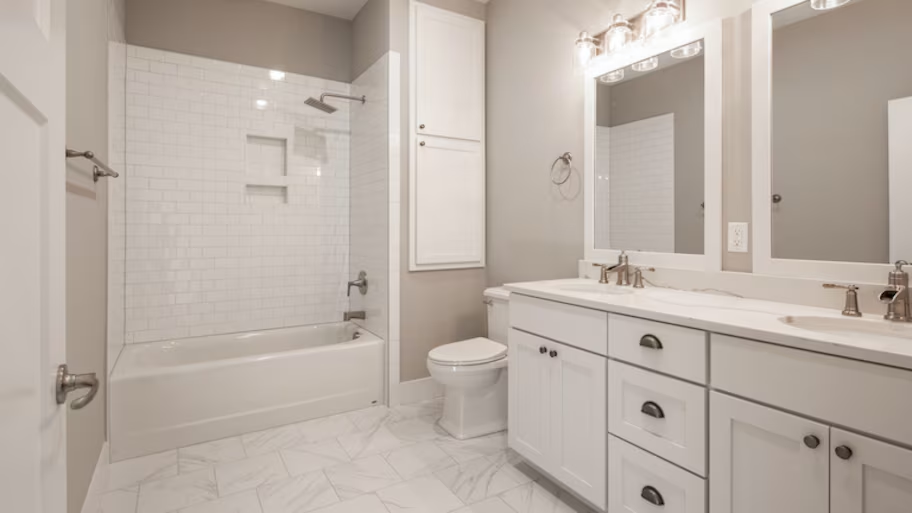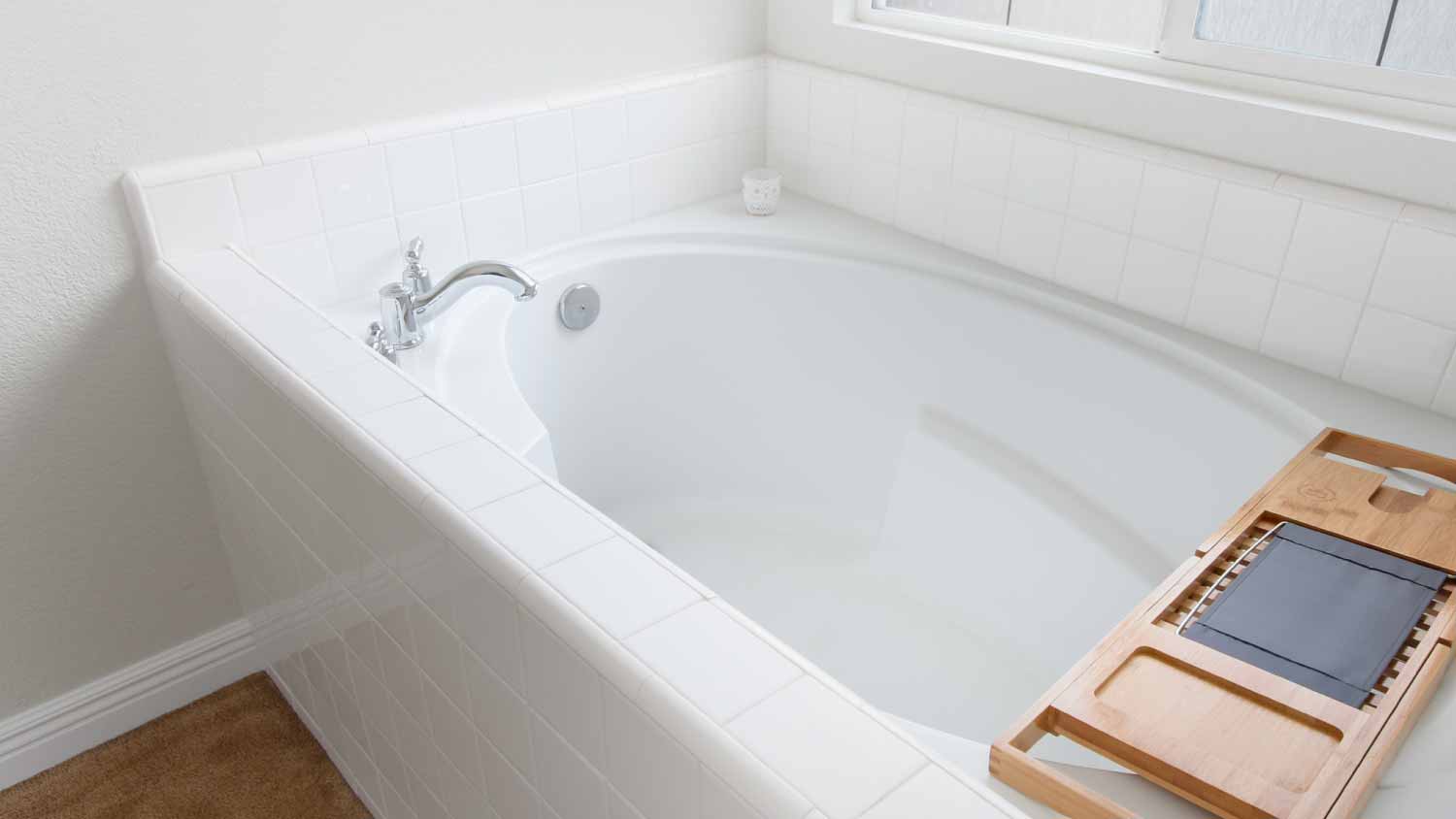
Curious how much a shower remodel costs? From new fixtures to full installations, we have the prices you need to know to establish a shower remodel budget.
You and your rubber ducky will love this cozy bathing nook


Alcove tubs fit into recessed spaces with one side exposed.
They are available in a range of styles, materials, and types.
Proper maintenance and regular cleaning are the key to making any tub last.
Alcove bathtubs cost between $200 and $1,600.
Few elements hold as much promise for relaxation and rejuvenation when turning a bathroom into a sanctuary as the humble bathtub. The alcove tub is a timeless and versatile option among diverse bathtub designs. For homeowners wondering what an alcove tub is, here’s what you need to know about its functionality, aesthetic appeal, and costs.
In contrast to a freestanding soaking tub, an alcove tub fits snugly within a recessed space in the bathroom, enclosed by walls on three sides. The exposed side of the tub is called a skirt and may have a recessed decorative element. Additionally, alcove tubs are equipped with three-sided tile flanges to prevent moisture from seeping into the walls. The tub’s snug placement provides a sense of enclosure, lending to a cozy bathing experience.
Depending on the size of your bathroom and the layout, an alcove bathtub may be the most viable option unless you plan to knock down a wall for a larger bathroom remodel. If you’re nearing the end of your bathtub’s lifespan and thinking about switching things up, here are some pros and cons to consider.
| Pros | Cons |
|---|---|
| Affordable and accessible | Limited placement options |
| Easy to install and maintain | Limited materials to choose from |
| Saves space in smaller bathrooms | More functional than fashionable |
Alcove bathtubs are championed as an affordable option that helps maximize space in smaller bathrooms. Since they come in standard sizes, they’re often the default option in apartments and new builds. Here are some pros.
While you can get luxury models, most alcove tubs are made from budget-friendly materials like acrylic or fiberglass. Beyond this, the straightforward installation process, which involves limited materials and plumbing modifications, helps keep costs low.
Installing an alcove tub is straightforward, especially in bathrooms with a designated alcove space. Since they fit snugly within three walls, there's no need for additional framing or complex plumbing modifications. All of the above can translate to cost savings regarding materials and labor.
While alcove tubs may not offer the same level of accessibility as walk-in or freestanding tubs, their design can still accommodate various accessibility needs. For individuals with mobility challenges, grab bars and non-slip surfaces can be added to enhance safety and ease of use. Compare the cost of an alcove tub to the cost of a walk-in tub to understand the savings.
Alcove bathtubs are championed as an affordable option that helps maximize space in smaller bathrooms. Since they come in standard sizes, they’re often the default option in apartments and new builds. Here are some pros.
While you can get luxury models, most alcove tubs are made from budget-friendly materials like acrylic or fiberglass. Beyond this, the straightforward installation process, which involves limited materials and plumbing modifications, helps keep costs low.
Installing an alcove tub is straightforward, especially in bathrooms with a designated alcove space. Since they fit snugly within three walls, there's no need for additional framing or complex plumbing modifications. All of the above can translate to cost savings regarding materials and labor.
While alcove tubs may not offer the same level of accessibility as walk-in or freestanding tubs, their design can still accommodate various accessibility needs. For individuals with mobility challenges, grab bars and non-slip surfaces can be added to enhance safety and ease of use. Compare the cost of an alcove tub to the cost of a walk-in tub to understand the savings.
Universal design aims to make bathrooms functional and safe for all in the home. Features include grab bars, a comfort height toilet, slip-resistant flooring, a shower seat, a walk-in tub, a curbless shower, and making the bathroom wheelchair accessible.
Alcove bathtubs are a great way to save space in your bathroom. You can install them right against a wall or tuck them neatly into a corner. They don’t require as much floor space as a freestanding tub, and you can use the connecting walls for extra storage by adding recessed shelving or ledges. In addition, most alcove tubs are tub-shower combos, which give you two fixtures in the space of a single fixture.
Alcove tubs are simple to maintain and easy to clean. They don’t have tricky edges that collect dust and grime. Instead, you’ll only need to clean the inside of the tub and the front apron.
Freestanding tubs, on the other hand, have more surface area. You’ll need to clean the entirety of the exterior of the tub, exposed piping, and—if you have a claw-foot tub—the feet, the underside of the tub, and the floor beneath.
Though alcove bathrooms are a great way to maximize space, they’re not the most versatile choice. While you can upgrade to an air bath or jetted alcove tub depending on the model, material and placement is limited.
Other types of bathtubs, like freestanding or drop-in tubs, can be placed anywhere in a room where you can fit a plumbing connection. In comparison, alcove tubs are limited to an alcove most commonly located at the back of a bathroom. A bathtub installer can help you determine if you have space for an alcove bathtub.
Most brands only manufacture alcove tubs in acrylic, fiberglass, or enameled steel. While these materials are durable, other types of bathtubs have a larger range of options, including ceramic, cast iron, cultured marble, granite, and copper.
Alcove bathtubs are offer functionality—especially if you choose a tub-shower combo. Unfortunately, most homeowners or potential buyers don’t view them as the most attractive or luxurious option. Alcove tubs are considered standard, while freestanding tubs and drop-in tubs are considered high-end and allow for a more customized bathroom look.
Alcove tubs come in various types, each offering distinct features to suit different preferences and needs.
It's the most common type across various bathroom styles, from builder-grade to luxurious. They are prized for their simplicity and functionality, boasting options in both rectangular and oval shapes.
Ahh, nothing spells spa at home like a whirlpool tub. Alcove whirlpool tubs have built-in jets, adding a therapeutic element to the bathing experience. These jets produce a massaging effect by circulating water, which can help relax muscles and alleviate tension. Tubs like these allow homeowners to enjoy the benefits of hydrotherapy in their own abodes.
These offer profound, immersive bathing experiences. They are deeper and broader than standard tubs, allowing bathers to submerge and unwind fully. Alcove soaking tubs come in various materials, including acrylic, cast iron, and fiberglass, offering durability and comfort for long, leisurely soaks.
Alcove shower-tub combos are versatile fixtures that combine a bathtub and shower in one secluded space. These tubs feature a shower head and faucet above the tub, allowing users to switch as needed. Alcove shower-tub combos are popular in bathrooms with limited space or for homeowners looking to maximize functionality without sacrificing style.

Proper maintenance is essential to ensure the longevity of any tub. Remember that most types of tubs are built to last, with iron bathtubs being the most durable, lasting 50 years or more.
Regular cleaning: Clean your alcove tub regularly with a mild, non-abrasive cleaner and a soft sponge or cloth.
Prevent mold and mildew: Keep both at bay by ensuring proper bathroom ventilation and regularly wiping down the tub to remove excess moisture.
Address leaks promptly: If you notice any leaks or water damage around the tub, address them promptly to prevent further damage.
Check seals: Inspect the caulking and grout around the tub regularly and reseal or repair as needed.
Protect the surface: Use a bathtub mat or non-slip decals to protect the tub's surface and prevent scratches.
Maintain fixtures: Regularly clean and inspect for any signs of wear or corrosion and replace as needed.
Install a bath liner: It is a great way to turn a grubby tub into one that feels new; discover how to install a bath liner.
Alcove tubs are readily available at most home improvement stores, with prices ranging from $200 to $1,600 based on type and material. The labor cost to replace a bathtub falls between $100 and $2,000, depending on your location. However, expenses may escalate if plumbing lines need relocation, heavy tubs require removal or installation, or repairs to subflooring are necessary. To obtain the best estimate, speak to a local bathtub installer.
From average costs to expert advice, get all the answers you need to get your job done.

Curious how much a shower remodel costs? From new fixtures to full installations, we have the prices you need to know to establish a shower remodel budget.

Building a laundry room addition to your home adds value and functionality. Your laundry room addition cost will depend on size, materials, and other factors.

Building an addition can increase your home's value and provide more space to live, but it does come at a cost. Read on to learn how much it costs to build a room addition based on factors like location, type, and size.

An updated bathtub can give a bathroom a whole new look. Find out how much it costs to replace a bathtub in Austin, TX, including prices by type and labor costs.

An updated bathtub can give a bathroom a whole new look. Find out how much it costs to replace a bathtub in Houston, TX, including prices by type and labor costs.

DIY sink installation is a doozy but do-able for those with experience. Use this guide to learn how to install a bathroom sink in a few steps.